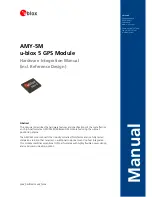
14
ducer does "kick-up," the bracket can easily be pushed back into place
without tools.
Read these instructions carefully
before
attempting the installation.
Determine which of the installation methods is right for your boat. Use
extreme care if mounting the transducer inside the hull, because once
the epoxy is applied and it is set into position, the transducer cannot be
removed.
Remember, transducer location is the most critical part
of a sonar installation.
Recommended Tools and Supplies
If you prefer the option of routing the cable through the transom, you
will need a 1" (25.4 mm) drill bit. A transom mount requires use of a
high quality, marine grade
above- or below-waterline sealant/adhesive
compound.
NOTE:
The following installation types also call for these recommended
tools and required supplies (supplies are
not
included):
Single-frequency transom installations
Tools include: two adjustable wrenches, drill, #29 (0.136") drill bit, flat-
head screwdriver. Supplies:
high quality, marine grade
above- or below-
waterline sealant/adhesive compound.
Dual-frequency transom installations
Tools: two adjustable wrenches, drill, #20 (0.161") drill bit, flat-head
screwdriver. Supplies: four, 1" long, #12 stainless steel slotted wood
screws,
high quality, marine grade
above- or below-waterline seal-
ant/adhesive compound.
Single-frequency trolling motor installations
Tools: two adjustable wrenches, flat-head screwdriver. Supplies: plastic
cable ties.
Shoot-through hull installations
Tools: these will vary depending on your hull's composition. Consult
your boat dealer or manufacturer. Other tools are a wooden craft stick
or similar tool for stirring and applying epoxy, and a paper plate or
piece of cardboard to mix the epoxy on. Supplies: rubbing alcohol, 100
grit sandpaper, specially formulated epoxy adhesive available from LEI
(see ordering information on the inside back cover). A sandwich hull
also requires polyester resin.
Selecting a Transducer Location
1. The location must be in the water at all times, at all operating speeds.
2. The transducer must be placed in a location that has a
smooth flow
of
water at all times. If the transducer is not placed in a smooth flow of
Summary of Contents for LMS-334c iGPS
Page 62: ...54 Notes ...
Page 98: ...90 Notes ...
Page 102: ...94 Notes ...
Page 134: ...126 Notes ...
Page 148: ...140 Notes ...
Page 182: ...174 Notes ...
Page 197: ...189 Notes ...














































